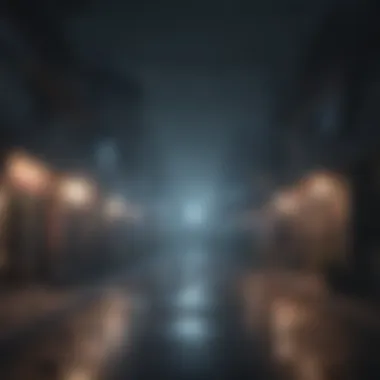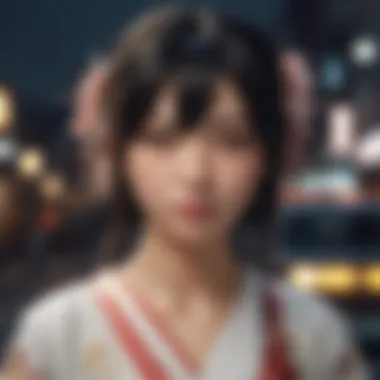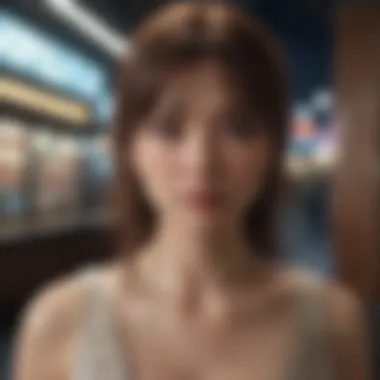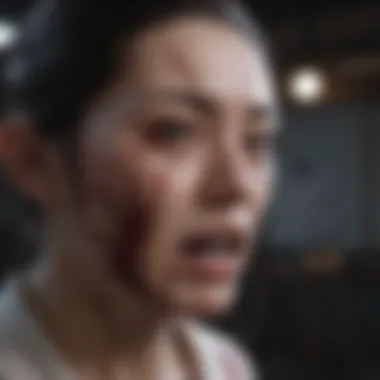Exploring Shiki on Crunchyroll: A Deep Dive into Horror Anime


Intro
Shiki is a unique entry in the horror anime genre that has captivated audiences on Crunchyroll. This anime series stands out for its chilling narrative and complex themes, which explore the essence of humanity against a backdrop of supernatural horror. Understanding Shiki involves a closer look at its characters, the dynamics of its story, and how it has been received in the crowded anime landscape.
Industry Insights
Emerging Trends in Anime Industry
The anime industry continues to evolve, and Shiki exemplifies some of the more recent trends gaining traction. Psychological themes and darker narratives have become increasingly popular, appealing to a mature audience. These trends reflect a shift toward more complex storytelling in anime, where character analysis and moral ambiguity take center stage. Shiki's exploration of the nature of good and evil resonates with contemporary viewers, highlighting the anime's relevance in today's market.
"Anime is not just for kids anymore; it's a medium that invites everyone to question underlying fears and societal norms."
In recent years, there has been a noticeable increase in horror-themed anime. This surge indicates a broader acceptance and desire for genres that provoke thought and reflect on human nature. Shiki, with its unsettling atmosphere and philosophical exploration of the human experience, fits into this new wave of content that challenges mainstream expectations.
Impact of Streaming Platforms on Anime Consumption
Crunchyroll has played a pivotal role in popularizing series like Shiki, making it accessible to a global audience. The platform's focus on streaming has allowed niche genres to find their place, engaging viewers who might not have encountered such works through traditional airing methods. Through its service, Crunchyroll has facilitated discussions and communities around shows, enhancing the viewing experience for fans.
Reviews & Recommendations
Must-Watch Anime Recommendations
For fans who appreciate Shiki, there are other anime series worth exploring:
- Another: A horror series centered on a cursed classroom that results in mysterious deaths.
- Paranoia Agent: This show mixes psychological horror with social critique.
- Higurashi: When They Cry: Renowned for its complex storytelling and intense atmosphere.
These shows share thematic elements of fear, morality, and the dark sides of human nature, similar to what Shiki offers.
Ending
In summary, Shiki provides a profound analysis of horror intertwined with philosophical questions about humanity. Its success on Crunchyroll epitomizes the growing demand for sophisticated storytelling in the anime realm. As viewers continue to embrace this evolution, Shiki remains a critical piece of the horror anime landscape.
Prelude to Shiki
In the realm of horror anime, Shiki stands as a notable title that pushes the boundaries of traditional storytelling. It is essential to examine this series due to its unique approach to themes of mortality, humanity, and the grotesque. As we're witnessing a growing fascination with horror genres, analyzing Shiki provides valuable insights into the intricacies of character development and narrative techniques that contribute to its chilling atmosphere. This section sets the stage for a comprehensive understanding of Shiki’s impact, not only in anime culture but also within the broader context of horror narratives.
Genre and Overview
Shiki can be classified primarily as a horror anime, but it transcends simple genre labels. It intricately weaves elements of supernatural fiction, psychological thriller, and drama, creating a multilayered viewing experience. The horror is not limited to scare tactics; it is deeper, probing into the moral complexities faced by characters encountering death and existence. Understanding these genres helps viewers appreciate the depth of the narrative.
The series is based on a novel by Fuyumi Ono, showcasing a strong adaptation that remains faithful to the source material while infusing fresh perspectives. This balance between anime and original literature sets a benchmark in how adaptations can retain thematic fidelity while appealing to modern audiences.
Premise and Setting
Shiki is set in a quaint, seemingly tranquil village named Sotoba, which becomes the epicenter of mysterious deaths that plague its residents. The initial atmosphere captures rural charm, with sunlit fields and close-knit community interactions that starkly contrast the horrific events that unfold. As the narrative progresses, viewers witness the transformation of this peaceful setting into a breeding ground for fear and paranoia.
The premise revolves around the villagers’ struggle against a formidable enemy - the Shiki, mystical creatures that blur the lines between life and death. This creates a rich backdrop, posing critical questions about humanity’s reaction to the supernatural and the ethical dilemmas that arise in the face of survival. Exploring this premise allows the audience to engage with existential themes, enhancing their viewing experience beyond mere entertainment.
The careful establishment of setting and premise is pivotal to Shiki’s narrative effectiveness, as it lays the groundwork for the thematic explorations that follow in the subsequent sections.
Thematic Elements of Shiki


The thematic elements in Shiki are crucial to understanding both the narrative and the emotional resonance of the series. The exploration of core themes not only enhances the viewing experience but also invites deeper reflection on critical life questions. Themes surrounding life, death, and humanity are interwoven throughout the storyline, providing a rich context for character motivations and conflicts. This section will delve into these thematic elements, illuminating how they contribute to Shiki's place in the horror anime genre.
Exploration of Life and Death
In Shiki, the themes of life and death manifest as central tenets driving the narrative forward. The story revolves around the consequences of death in a small town plagued by mysterious occurrences. Death in Shiki is not purely an end; instead, it prompts serious inquiries into what it means to truly live. The duality of existence is explored as characters grapple with the loss of loved ones and the fear of their own mortality.
One notable point is how the portrayal of the undead deviates from typical horror tropes. Rather than merely showcasing vampires as malevolent beings, Shiki examines their existence. This provides a nuanced perspective on life interrupted by death, leading viewers to question whether the undead can have their own form of life. The conflict deepens as the living characters confront their fears and prejudices, forcing them to reconsider their understanding of humanity.
Another significant aspect is the impact of societal responses to death. The residents of the town, dealing with rising fatalities, react in varied ways. Their actions illustrate how fear of death can lead to irrationality and violence, thereby providing commentary on human nature under distress. By placing characters in these scenarios, Shiki compels viewers to confront their theories about life and what follows.
The Nature of Humanity
The nature of humanity in Shiki emerges as a focal point, reflecting the darkness inherent within individuals. As characters navigate their circumstances, their choices reveal profound truth about human instincts. Initially, many characters appear moral or virtuous, but as the plot unfolds, their true faces emerge.
Interestingly, the show provokes a strong examination of morality. What constitutes right or wrong becomes blurred as characters justify their actions based on survival, fear, or vengeance. When faced with existential threats from the undead, the line separating victim from perpetrator becomes extremely thin. In this way, Shiki challenges audiences to contemplate their moral compass. Are humans inherently good, or is there a darker side that surfaces under pressure?
Additionally, Shiki questions social constructs that shape human interaction. The bonds of community fray as fear spreads, revealing how easily societal norms can collapse. This breakdown serves as a chilling reminder of what can happen when individuals act solely in self-interest. Ultimately, Shiki opens a dialogue on humanity’s nature, urging its audience to reflect on the principles that guide their own lives.
"The exploration of life and death is only the beginning; understanding humanity's essence is where the true horror lies."
Thus, the thematic elements of Shiki provide a critical lens through which the series can be analyzed. The exploration of life and death, coupled with a profound inquiry into humanity’s nature, sets the stage for a thought-provoking narrative, resonating with audiences long after the credits roll.
Character Analysis
Character analysis is a vital component in understanding the layers of narrative in Shiki. The choices made by each character reflect their complexities and moral dilemmas. This depth enhances the overall viewing experience. A well-crafted character can evoke different reactions, prompting viewers to reflect on their own beliefs and choices. In horror anime like Shiki, characters serve as a mirror to humanity's darker traits. This exploration provides insights into how fear and existential threats shape behaviors and relationships within the storyline.
Shiki's Protagonists
The protagonists in Shiki embody the conflict between survival and ethical considerations. Natsuno Yuuki stands out as a complex figure. His transformation from a skeptical teenager to a fierce defender of his beliefs highlights the struggle against overwhelming odds. His character arc is crucial, showing the impact of isolation and fear. Another significant character is Akira Tobio, who witnesses the changes in her village and grapples with her responses to the unfolding nightmare. Each protagonist has a unique approach to the horrors they face, illustrating various forms of human resilience and adaptability.
Antagonists and Their Motivations
The antagonists in Shiki are not merely evil figures but represent a broader commentary on existence. The Shiki themselves embody the struggle between humanity and monstrosity. Characters like Sunako are portrayed not only as killers but also as victims of their circumstances. Their motivations reveal a desire for survival, pushing them to commit acts that challenge viewers' notions of right and wrong. Understanding these motivations creates a rich narrative tension, as audiences are forced to confront the gray areas between good and evil, and the moral ambiguities that arise in dire situations.
Supporting Characters and Their Roles
Supporting characters in Shiki enrich the story by adding texture to the narrative. Characters like Dr. Ozaki act as the voice of reason and scientific inquiry. His struggles to comprehend the events in the village seem to symbolize the clash between rationality and superstition. Meanwhile, the townspeople reflect a community's diverse responses to crisis. Each supporting character serves a purpose in the plot, reinforcing themes of fear, denial, and conflict. This layered character mix helps strengthen the story, making it more engaging and thought-provoking.
Narrative Structure and Style
The narrative structure and style of Shiki plays a pivotal role in conveying its complex themes and engaging the audience. The series employs a multilayered approach that not only enhances storytelling but also shapes the viewer's emotional journey. This article will examine critical elements such as pacing, plot development, the use of flashbacks, and foreshadowing.
Pacing and Plot Development
Pacing is crucial in horror anime, as it dictates how tension is built and sustained throughout the series. In Shiki, the pacing alternates between moments of slow, eerie buildup and sudden bursts of horror, captivating the viewer's attention. This fluctuation keeps the audience on edge, creating a sense of dread that is central to the horror genre.
The story's plot unfolds gradually, allowing character relationships and backstories to evolve in tandem with the escalating horror. Viewers become invested in the characters' fates, which adds weight to the narrative when pivotal moments occur. Each episode is carefully crafted to end with cliffhangers or unresolved questions, prompting viewers to continue watching and deepen their emotional engagement.
Additionally, Shiki employs a non-linear storyline. This technique enriches the narrative by revealing different character perspectives over time. Thus, the audience gradually uncovers the chilling reality of the events as pieces of the plot come together in unexpected ways.
Use of Flashbacks and Foreshadowing
The effective use of flashbacks in Shiki allows the narrative to explore characters' pasts, shedding light on their motivations and fears. Flashbacks serve as a narrative device that emphasizes the contrast between the characters' former lives and the nightmare they currently face. By juxtaposing their peaceful past with their present horror, the viewers gain insight into the emotional stakes involved in the characters' struggles.


Foreshadowing is another essential technique that Shiki utilizes to build suspense and enhance the overall narrative experience. Subtle hints and clues scattered throughout the episodes create a sense of predestined doom. This not only heightens anticipation but also invites the audience to actively engage with the story as they try to piece together the impending tragedies.
In summary, the narrative structure and style of Shiki are intentionally crafted to strengthen its thematic resonance. Pacing and plot development, along with the strategic use of flashbacks and foreshadowing, contribute to a vibrant storytelling experience that encourages viewers to analyze and reflect, elevating the series beyond mere entertainment.
Visual and Audio Presentation
The visual and audio presentation of Shiki is critical in creating an immersive atmosphere that enhances the narrative. This anime not only relies on its storytelling but also on how it portrays its horror elements through visuals and sound. These components are essential to convey the intended emotions and aesthetic quality. The integration of animation styles and sound design plays a significant role in how audiences experience the series.
Animation Style and Quality
Shiki features a distinct animation style that stands out in the horror genre. The visual aesthetic combines detailed character designs with moody backgrounds, which reflects the dark themes of the story. The characters often have exaggerated expressions, adding a layer of unsettling tension. Each frame is crafted with a focus on the eerie and the grotesque, capturing the essence of its narrative.
Moreover, the quality of animation varies with key scenes to emphasize dramatic moments. Shadows and lighting are thoughtfully utilized to create a foreboding atmosphere. This choice in animation style not only serves to enhance the horror elements but also distinguishes itself from other anime in the same category. Fans appreciate the effort in quality, which contributes to the overall impact of the story.
Sound Design and Music Score
Sound design in Shiki is meticulously crafted and serves a dual purpose. It promotes immersion into the story while enhancing feelings of dread and tension. The ambient sounds often mimic natural environments, which contrasts sharply with the eerie events unfolding. Sounds of wind, rustling leaves, and distant howls enrich the viewing experience.
The music score complements this design, featuring haunting compositions that linger in the background during tense scenes. It skillfully builds anxiety without overwhelming the narrative. The choice of instrumentation—often haunting strings and dissonant chords—captures the unsettling themes of the series perfectly.
For many viewers, the sound and animation together create an unforgettable experience that elevates the series beyond its plot.
In summary, both the animation style and audio presentation of Shiki are not merely supplementary; they are integral in framing the viewer's experience. These components deepen the understanding of the narrative and enrich the emotional engagement with the characters and themes.
Cultural Impact and Reception
The cultural impact of Shiki reaches beyond its narrative and artistic elements. Understanding its reception provides insights into how a work can shape discussions within the anime community. This aspect is crucial as it informs potential viewers of Shiki’s significance in the horror genre and its broader implications for anime as a medium.
Critical Reception and Reviews
Critics have analyzed Shiki from various angles since its release. Reviews often praise the series for its thought-provoking themes and psychological depth. The tension between the portrayal of humanity and monstrosity is a recurring motif that has intrigued viewers.
For example, Anime News Network highlights the series' ability to grapple with moral ambiguity and the nature of evil. Such analysis provides viewers context that elevates their viewing experience.
Moreover, Shiki holds a respectable rating on platforms like MyAnimeList and IMDb, indicating a favorable reception among audiences.
However, responses are mixed. Some viewers find its pacing disjointed or experience confusion regarding its complex character arcs. These varied critiques shape Shiki’s identity within horror anime. They also reinforce its role in sparking debate about what constitutes horror in anime.
"Shiki challenges the viewer, pushing them to reflect on their perceptions of good and evil while engaging with a unique narrative style."
In this light, Shiki manages to maintain relevance in discussions about horror storytelling, influencing both critics and fans alike.
Audience Engagement and Fanbase
The reception of Shiki extends into the fan community, which has cultivated an active dialogue around the series. Engaged fans often contribute to its lasting legacy through discussions on forums like Reddit and by producing fan art and theories.
Social media platforms also amplify this engagement. Fans frequently share their thoughts on Facebook groups dedicated to horror anime, examining episode themes and character decisions. This creates a vibrant community where viewers can dissect and appreciate the finer points of the series.
Moreover, conventions have seen panels dedicated to discussing the impact of Shiki. These gatherings provide a space for fans to engage with creators, fostering closer connections and a sense of shared understanding around themes presented in the show.
Shiki on Crunchyroll


Exploring the presence of Shiki on Crunchyroll reveals its significance in the world of anime streaming. The platform serves as a crucial medium for fans to access this horror series easily. Crunchyroll not only offers a centralized location for watching the anime, but also provides additional features that enhance the viewing experience. The availability of Shiki on this platform indicates its importance among contemporary anime offerings, catering to both seasoned viewers and new audiences looking to delve into horror genres.
Availability and Accessibility
Shiki is accessible on Crunchyroll with the convenience that it brings. Users can stream all episodes directly from their devices, be it a smartphone, tablet, or desktop. The anime is available with subtitles in multiple languages, which caters to a global audience.
Moreover, Crunchyroll offers various membership options. Free users can watch with ads, while premium users enjoy an ad-free experience along with other exclusive content. This flexibility allows viewers to choose their desired level of engagement without barriers. An important aspect is its compatibility with various devices, making it easy for fans to watch on the go.
Viewer Experience and User Interface
The user interface of Crunchyroll is designed for ease of use, which aids in viewer engagement. The platform offers a straightforward layout that allows viewers to navigate between series, including Shiki. You can find dedicated sections for popular anime, new releases, and personalized recommendations based on watched content.
Loading times are generally minimal, ensuring a smooth streaming experience. Additionally, users can create watchlists, making it simpler to keep track of episodes sequentially. The inclusion of community features, such as user ratings and comments, fosters discussions around Shiki and enhances viewer interaction.
"The availability of titles such as Shiki on streaming platforms changes how fans experience and engage with anime, creating a community of viewers who share their insights and reactions."
This interface greatly complements the horror themes present in Shiki, enhancing the overall immersion as viewers delve into the chilling narrative and develop a connection with the characters. As technology continues to evolve, so does the Shiki experience, encouraging ongoing engagement from its audience.
Comparative Analysis with Other Horror Anime
The examination of Shiki within the broader scope of horror anime illuminates both its unique attributes and the commonalities it shares with its genre counterparts. This comparative analysis is crucial to understanding how Shiki not only stands out but also contributes to ongoing dialogues about horror narratives in anime. Identifying these parallels aids in contextualizing character motivations and thematic depth, ultimately enhancing viewers' appreciation of the series.
Contrasting Themes and Styles
Shiki distinguishes itself through its intricate exploration of life, death, and the human psyche. Unlike traditional horror anime that often relies on jump scares or grotesque imagery, Shiki's horror is rooted in the psychological and existential ramifications of vampirism. This theme resonates on multiple levels, as it asks deeper questions about what it means to be human.
In contrast, series like Another or Corpse Party focus more on supernatural events, creating tension through mystery and shock value. The horror in these works often derives from external circumstances rather than internal ethical dilemmas. This distinction highlights how Shiki elevates its narrative through a philosophical lens, prompting viewers to reflect on moral decisions and the consequences of survival.
- Shiki's approach to horror focuses on:
- Comparisons to other series might reveal:
- Psychological conflict
- Ethical dilemmas surrounding survival
- External threats vs. internal struggles
- Prevalence of shock value vs. character depth
The animation style in Shiki also departs from many conventional horror series. While shows like Paranoia Agent employ surreal visuals to augment the eerie atmosphere, Shiki opts for a more subdued yet haunting aesthetic. The color palette and character designs contribute to a brooding ambiance that subtly enhances the storytelling.
Influence on Subsequent Works
Shiki's impact extends beyond its runtime, influencing the horror anime landscape in notable ways. Many subsequent horror series have drawn inspiration from Shiki's character complexity and moral narratives. Shows such as Hellsing Ultimate and Vampire Hunter D: Bloodlust exhibit richer character arcs as a result of this trend, illustrating how Shiki has shifted viewer expectations about complexity in horror storytelling.
The portrayal of sympathy towards villains and morally ambiguous characters can also be traced in later anime. Where earlier works might strictly delineate good from evil, Shiki’s nuanced exploration invites ongoing examination of character motivations. This shift represents a broader cultural movement within horror genres, advocating for deeper emotional engagement with characters.
"Shiki challenged conventional boundaries, encouraging a more nuanced exploration of horror that resonates with contemporary audiences."
The legacy of Shiki thus serves as a critical reference point for both creators and enthusiasts, fostering a wave of narratives that blend horror with philosophical inquiry. Through its distinctive themes and deep characterization, Shiki has paved the way for future horror anime to engage with more profound psychological and moral quandaries.
End
In examining Shiki, it becomes clear how pivotal this anime is for the horror genre within the broader context of anime culture. The series not only entertains but also provokes deeper contemplation on themes of mortality, humanity, and fear. Its intricate narrative structure and character complexities deliver a rich tapestry that resonates with viewers, highlighting both the fragility of life and the dark potential lying within human nature.
Final Thoughts on Shiki's Legacy
Shiki has carved a notable niche in the horror anime landscape. Its legacy is evident through the numerous discussions it generates among fans and critics alike. The horror elements are meticulously woven with emotional depth, resulting in a series that stands apart from conventional horror media. This uniqueness has led to the show being cited in various forums and discussions, further solidifying its reputation. The way Shiki handles the themes of life and death encourages viewers not just to react in fear but to introspect, making its impact last well beyond the viewing experience.
Impact on the Future of Horror Anime
Shiki has undoubtedly influenced the direction of future horror anime. Its thought-provoking narrative and character development set a standard for storytelling within the horror genre. New series often draw inspiration from its themes and tone. Audiences have come to expect more than simple shock value; they seek depth and connection to the characters and their struggles. As viewers continue to demand complex narratives, Shiki opens the path for upcoming creators, highlighting the importance of not just the horror elements but the psychological intricacies behind them.
The resonance of Shiki can be seen in studios like MAPPA and Wit Studio, who have embraced more profound character explorations and moral dilemmas in their projects. The series’ legacy impacts not only viewer expectations but also industry standards in crafting horror narratives that are rich, layered, and truly engaging.



